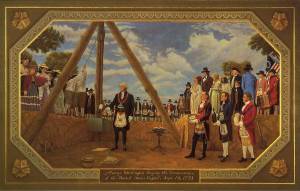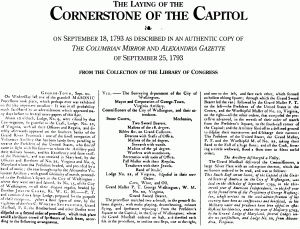Carolyn’s Online Magazine (#COMe)
PRES. GEORGE WASHINGTON
LAYS THE CORNERSTONE
FOR THE CAPITOL BUILDING ON 9/18/1793
I didn’t really set out to learn something new.
Well, maybe I did. I was curious. I’d read in a 100 Year History of Louis des Isles that a French woman gave her farm to one of my ancestors. All I really wanted to know was why she’d do that.
In time I learned Louis des Isles wasn’t really given the farm. He actually purchased it. But from finding the answer to my question I discovered a unique woman, Rosalie de Leval. Her story intrigued me. I set out to learn more, and ended up with my novel-under-construction, She Saw Her Promised Land.
Again, I didn’t set out to write a novel. It just evolved, then took over my life.
Unfortunately, it took me on a learning journey. Virtually every chapter, virtually every event, was unknown to me. I’ve spent time learning about the Scioto Associates, Gen. Henry Knox and William Duer’s post Revolutionary War exploits in land speculation, stock market crash effects, religious freedom in the Maine Territory of Massachusetts, Braddock’s Road…well, you get my learning picture.
This week I’m learning about and writing about the 1793 yellow fever epidemic in Philadelphia, and the September 18, 1793, laying of the cornerstone for the Capitol Building in Washington, D. C.
President George Washington (or General Washington, as he preferred to be called) braved the contagion of the epidemic to lay the cornerstone. What I learned was that the ceremony was a Free Mason event.
Rosalie didn’t attend the ceremony because she was at her farm, Fontaine de Leval, in Trenton (now Lamoine), Maine. Her friend Franco van Berckel, the second Dutch ambassador to the United States, related the story to Rosalie and a neighbor girl, Mary, during a visit to her farm.
Below is the chapter’s first draft.
“Did you attend the ceremony?” Mary asked.
“Yes, and it was a magnificent ceremony. Here’s the report from the Alexandria Gazette. It has a comprehensive report about Gen. Washington laying the cornerstone on September 18. This was the first large public event staged in the federal city, and if future public events are as spectacular Washington will be a star capitol.”
Rosalie pushed the newspaper aside.
“I’ll read this later. II want to hear your rendition of the event.”
“At 10:00 am Gen. Washington and his entourage appeared on the south bank of the Potomac River. A volunteer artillery from Alexandria escorted him across the river, where they were joined by Masonic lodges from Maryland and Virginia.
“Music played, drums beat, colors flew, and spectators cheered as the groups marched, two abreast, the one and a half miles to the site of the Capitol.
“Once they arrived the procession reformed. Gen. Washington, flanked by Joseph Clark (the Grand Master) and Dr. E. C. Dick (the master of the Virginia lodge), stood to the east of a huge stone while the others formed a circle west of it.
“Soon an engraved plate was delivered. Contemporary Masonic practice includes the laying of an inscribed metal plate along with a cornerstone,” Franco explained.
“Was it inscribed?” Mary asked.
“Let Franco tell the story, Mary,” Rosalie said.
“Yes, it was inscribed. Would you like to read the inscription, Mary?”
“Oh. Yes, I certainly would.” She picked up the newspaper and read:
This South East corner stone, of the Capitol of the United States of America in the City of Washington, was laid on the 18th day of September, in the thirteenth year of American Independence, in the first year of the second term of the Presidency of George Washington, whose virtues in the civil administration of his country have been as conspicuous and beneficial, as his Military valor and prudence have been useful in establishing her liberties, and in the year of Masonry 5793, by the Grand Lodge of Maryland, several lodges under its jurisdiction, and Lodge 22, from Alexandria, Virginia.
Thomas Johnson, David Stuart and Daniel Carroll, Commissioners Joseph Clark, R. W. G. M.—P. T. James Hoban and Stephan Hallate, Architects Collen Williamson, M. Mason
When she was finished Franco continued.
“When Gen. Washington received the plate, he, Joseph Clark and three ‘worshipful masters’ stepped into the foundation trench. The three bore corn, wine, and oil used to consecrate the stone.
“Gen. Washington laid the plate on the ground, and lowered the cornerstone onto it. A square, level, and plumb were used to determine the stone was set properly to be the foundation of the new building. Kernels of wheat were then sprinkled over it from a golden cup, symbolizing goodness, plenty and nourishment. Wine from a silver cup was poured over the stone, symbolizing friendship, health and refreshment. Finally, drops of oil glistened down the sides of the stone like the sacred oil that ran down upon Aaron’s beard in the Old Testament—‘to the skirts of his garments; as the dew of Hermon, and as the dew that descended upon the mountains of Zion.’ The oil symbolized joy, peace and tranquility.
“With the stone consecrated, Gen. Washington struck it three times with a gavel, as prescribed by Masonic custom.
“He exited the trench to ritual chanting by the assembled Masons and a 15-gun salute (one gun for each U.S. state) from the Alexandria Volunteer Artillery.
“Mr. Clark ended the formal exercises with a speech punctuated by numerous volleys from the artillery. After that, a 500 pound ox was barbequed. Those of us in attendance ‘generally partook, with every abundance of other recreation.’ The festivities ended before the dark of nightfall.
~~~~~~~~~~~~
While attempting to complete the novel in a historically correct but story-telling manner, I must say even if it isn’t the next great American novel it’ll be a success. What I’ve learned while researching and writing it is very applicable to today’s events. Perhaps the lesson is that things never change. They only take on different features, sometimes more pronounced, other times more camouflaged.
But most of all, from writing this story, I learned that the laying of the cornerstone did not seem to be a political event, but a Free mason event. And I wonder why.


Hey, I saw that portrait of you yesterday when I was in Conte Design. Your husband better buy that for you because you looked beautiful!!
________________________________
LikeLike
Karen, thanks. You always know the right thing to say. See you at the next ‘best place to be.’
LikeLike
Missed this comment, Karen. Thanks for the positiveness. I agree with you about what my husband should do.
LikeLike
Carolyn, thanks for sharing the history of the Capitol Building.
LikeLike